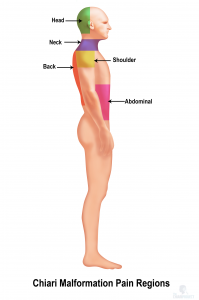CONTROL CHIARI
The Chiari Project empowers individuals who are suffering from such painful and debilitating conditions to take charge of their own life through self help educational tools so they can become more proactive in the Chiari community. Without proper self help resources, a strong sense of brain health would cease to exist. This is the reason why TCP has developed the Control Chiari movement so we can help the community improve their lifestyle and overall health. Stronger mindsets will allow integration for a healthier daily regimen.
Control Chiari ranges from conservative to surgical. Conservative treatments target neuropathic pain where they aim to reduce and prevent pain. On the other end of the spectrum, surgical treatment is typically reserved for more severe CM cases. Today, there are a wide variety of treatments that can mitigate the many symptoms of CM and decrease pain to a manageable level. Discovering the best treatment or combination of treatments, is key to quality of life improvement.

Botox Injections – CM patients who have neck pain might benefit from receiving a Botox injection in their neck for pain relief. Botox is a neurotoxin that works by blocking nerve signals that are responsible for sending pain, thereby relaxing stiff, sore, or spasming muscles.
CBD – An oil that may be taken orally, as a mixer into food or drinks, or used from a pipette, dropper, or skin paste. Unlike THC found in marijuana, CBD oil is not psychoactive, meaning users will not experience a “high”. CBD oil contains non inflammatory properties and may be helpful for those with CM. Unlike opioids and typical pain medication, medical marijuana and CBD oil shows no significant side effects in the central nervous system among people who use them.
Cognitive-based therapy – A method that helps patients identify thoughts and behaviors central to their pain. Muscle-related techniques also aim to relax the mind and body and can be administered by cognitive therapists. This form of psycho-cognitive therapy helps reduce stress surrounding the pain of CM.
Diet – Focus on a high-fiber diet for those which helps avoid straining while going to the restroom. Minimizing caffeine and alcohol intake may also help with pain management, enabling muscles to relax.
Medical Marijuana – Compared to commonly prescribed opioids, medical marijuana shows little risk for dependency. Those with CM who experience headaches and back pain may particularly benefit from medical marijuana.
Mindfulness – A method that includes breathing control, yoga, and progressive relaxation. Breathing techniques which aim to notice and control the breath may be incorporated for patients to develop a sense of autonomy and control over their experience.
Modifying physical activity – Avoid intense movements which might strain muscles. Instead, focus more on soft, gentle movements, such as yoga or pilates, for physical activities.
Muscle Relaxers, Analgesics, Soft Collars – Many painful symptoms associated with CM (i.e. headaches, neck pain, lower back pain) are caused by the lesion of junctional structures between the cerebral base and the cerebellum. When these lesions occur, pain occurs due to irritation. Analgesics, or painkillers, may be prescribed to relieve this pain from irritation. Muscle relaxants are drugs which suppress the central nervous system and help treat acute muscle pain. For CM patients with neck pain, these muscle relaxants may be helpful. Those with CM may also benefit from a variety of analgesics. However effective, these medications should be taken cautiously due to their addictive nature. In conjunction with oral medication, those with CM may also benefit from the use of a soft collar. Cervical spine pain associated with Chiari Malformation may be treated by placing a soft collar around the neck.
Physical therapy – An approach that aims to rehabilitate as well as improve muscular activity and movement. This is especially helpful for patients who experience muscular pain.
Social Support – Online chat rooms offer a safe place to educate, and be educated, by other individuals who are managing their Chiari. Always be cautious that you are on a reputable social chat room, as there may be online predators. The Chiari Project launched a Pain Management Research Group Discussion of their own, where the community can participate and create their own polls.
Surgery – Perhaps the most extreme method of treating the pain is foramen magnum decompression surgery, which reduces pressure on the cerebellum and consequently restores normal flow of spinal fluid. Headaches and migraines typically resolve following foramen magnum decompression. A study in 2012 examined the intraoperative findings and outcomes for brain surgery and found that 73% of patients reported improvement after three months. The goal of brain surgery is to decompress the cervicomedullary junction and restore normal CSF flow. Those with symptomatic CM are more likely to benefit from brain surgery.
